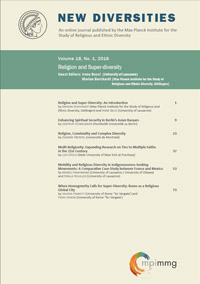When Homogeneity Calls for Super-Diversity: Rome as a Religious Global City
by Valeria Fabretti (University of Rome ‘Tor Vergata’) and Piero Vereni (University of Rome ‘Tor Vergata’)
To cite this article: Fabretti, V., & Vereni, P. (2016). When Homogeneity Calls for Super-Diversity: Rome as a Religious Global City. New Diversities, 18(1), 73–89. https://doi.org/10.58002/32em-8r54
This article addresses the way religious diversity is ‘taking place’ in Rome. In particular, it brings some religious manifestations into a broader understanding of the diversification of religious spaces in the city. Instead of seeing diversity as an unintended consequence of global flows, we trace it back to a sound religious spatial identity. Ever since globalization was set in motion, Rome has functioned as an attracting field of visibility for established religions. At the same time, the city has provided a shared grammar for inflecting diversity into religious idioms. Religious super-diversity as seen in Rome is the combination of a strong local religious identity that acts as a stage where old actors hope to be invited to give new performances and the audience itself is incessantly pushed to tread the boards. The article concludes with a tentative hypothesis that super-diversity may yield to postsecular modes of social life.
Keywords: religion, diversity, urban space, postsecular society, globalization, sacred places
|
